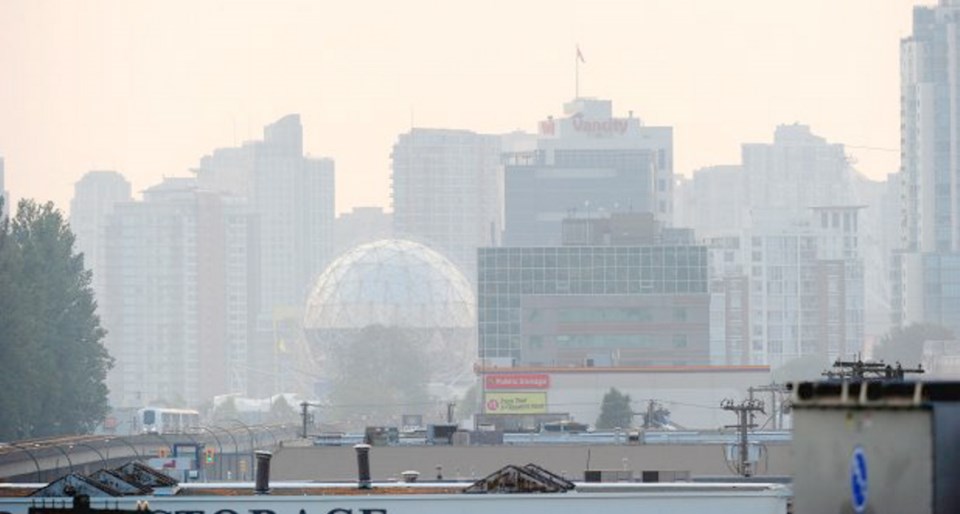A new international study showing that pollutants from China are affecting air quality on the west coast of North America is partly payback for western consumers having their goods manufactured there, a University of B.C. professor said Wednesday.
“Why are they having these high emissions?” asked Michael Brauer of the school of population and public health. “Part of it is the stuff they’re producing for us. Some of it is coming back to bite us ... through our consumption.”
As more manufacturing has gone offshore over the years, so has the pollution. And some of that is wafting back here on the air currents.
“In a sense, we’ve outsourced the problem to somebody else,” Brauer said in an interview. “We can’t just point a finger at China and say, ‘you guys clean up your act. You have this horrible pollution.’ We are actually part of the problem because we’re buying their goods.”
West Coast residents should respond to the study findings by taking greater action to reduce pollutants in their own back yard, he said. “When we see the global background increasing ... we have to be that much more careful about our own contribution. That’s what we can control.”
Brauer said the human health impacts are “pretty minor” with less than five per cent of Metro Vancouver’s air pollutants on average coming from offshore, although that can increase to 25 per cent on certain days.
Events such as dust storms in the Gobi Desert and forest fires in Siberia can especially impact local air quality, he said.
Matt Dodd, an environmental analytical chemist at Royal Roads University in Victoria, explained that under a “grasshopper effect,” pollutants get into the atmosphere then fall to earth when they hit colder weather. When conditions warm, they rise up again. Eventually, they settle in the Arctic and concentrate in the food chain, he said.
Dodd said that federal funding for monitoring of such pollutants dried up around 2010, quashing the university’s efforts to monitor for offshore air pollutants on Vancouver Island.
Danny Kingsberry, spokesman for Environment Canada, said it is estimated more than 95 per cent of the anthropogenic deposition of mercury in Canada is from foreign sources, with the East Asian contribution estimated at 40 per cent.
“Detecting the effect of the recent pollution episodes very much depends upon the weather conditions over Asia and the jet stream pattern from there to North America,” he said. “Without assessing such conditions using computer models, it is not possible to provide a definitive answer.”
The study published in the Proceedings of the National Academy of Sciences is the first to quantify pollution reaching the west coast from the Chinese manufacturing sector that produces everything from mobile phones to televisions for global export, according to a statement about the study from the University of California, Irvine, where one of the authors is based.
Los Angeles sees at least one extra day a year of smog that exceeds federal limits because of nitrogen oxides and carbon monoxide emitted by Chinese factories producing for export, the analysis found. China’s economic ascent has been accompanied by a surge in pollution and the World Bank estimates that the Asian nation has 16 of the 20 most-polluted cities globally.
“We’ve outsourced our manufacturing and much of our pollution, but some of it is blowing back across the Pacific to haunt us,” Steven Davis, a co-author of the study and an earth system scientist at the University of California, Irvine, said in the statement. “Given the complaints about how Chinese pollution is corrupting other countries’ air, this paper shows that there may be plenty of blame to go around.”
Winds called the “westerlies” can drive airborne chemicals across the ocean and lead to dangerous spikes in contaminants, according to the university’s statement. Dust, ozone and carbon may collect in valleys in California and other Western states, it said, while noting that China still isn’t responsible for the lion’s share of pollution in the U.S.
Jintai Lin of Beijing’s Peking University was the lead on the study and joined by experts at several global universities as co-authors.
In China, President Xi Jinping has pledged to tackle pollution amid rising public concern that smog and environmental degradation are affecting the nation’s health and the economy. The Ministry of Environmental Protection this month told all provinces and municipalities to cut air pollutants by as much as one quarter.
The Asian nation is the world’s largest emitter of anthropogenic air pollutants, according to the paper, with a fraction of its emissions caused by the manufacture of goods for foreign consumption. Anthropogenic pollutants typically refer to those originating from human activity.
In 2006, 36 per cent of anthropogenic sulphur dioxide, 27 per cent of nitrogen oxides, 22 per cent of carbon monoxide, and 17 per cent of black carbon emitted in China were associated with production of goods for export, according to the paper. For each of these pollutants, about 21 per cent of export-related Chinese emissions could be traced to U.S.-related exports, the paper said.
Black carbon, linked to conditions including asthma and cancer, is a “particular problem,” according to the University of California statement.
On some days, the export-related Chinese pollution contributed to as much as 24 per cent of sulphate concentrations over the western U.S., according to the study.
More than 600 million people were affected in China by a “globally unprecedented” outbreak of smog in the country that started last January and spread across dozens of provinces, lasting several months, Ma Jun, the founder and director of the Beijing-based Institute of Public & Environmental Affairs, told reporters on Jan. 15.
“Air pollution doesn’t have boundaries,” said Zhi Ning, an assistant professor at City University of Hong Kong’s School of Energy and Environment, who isn’t connected to the latest study. “It can come from China to the U.S., but it can also go the other way.”
With files from Bloomberg



